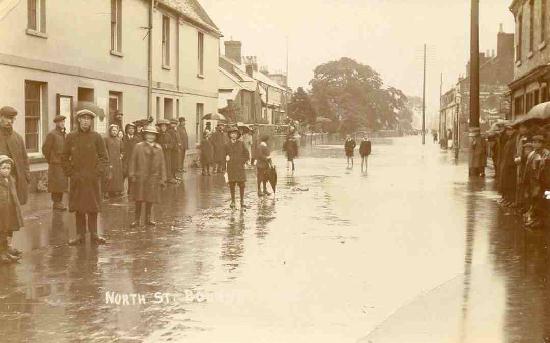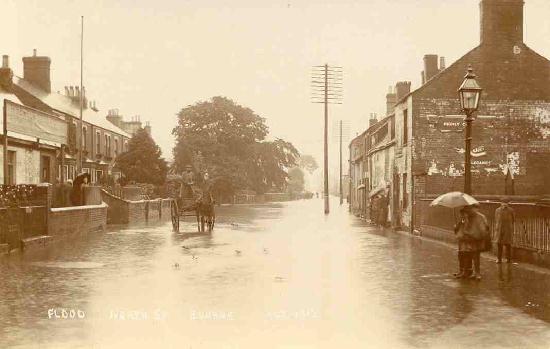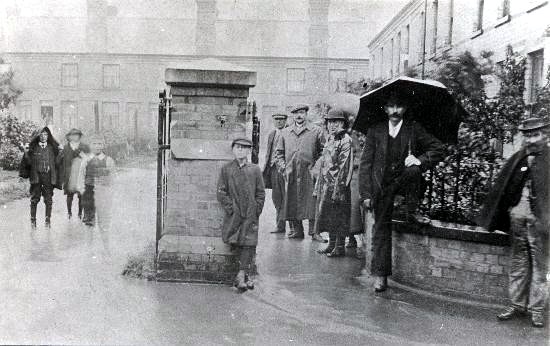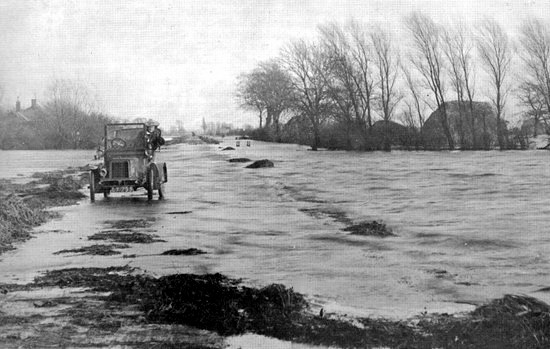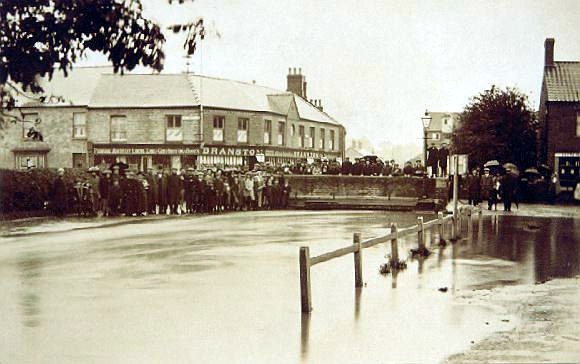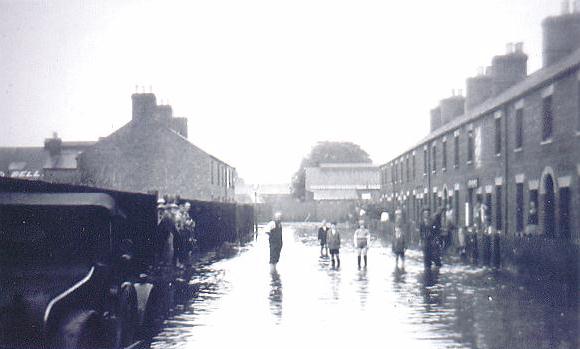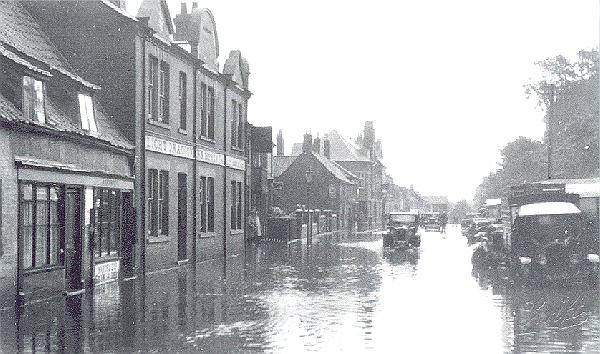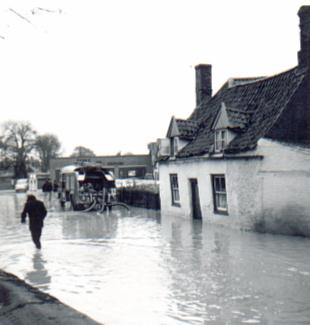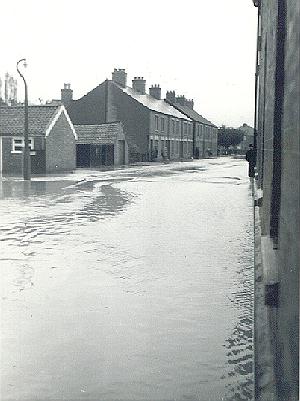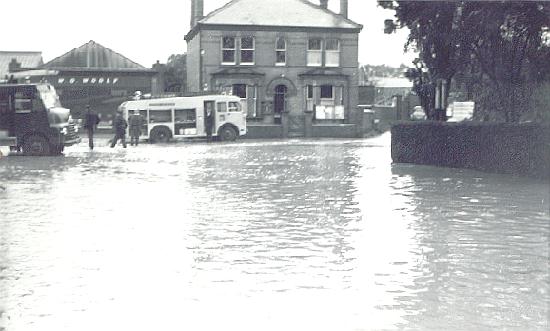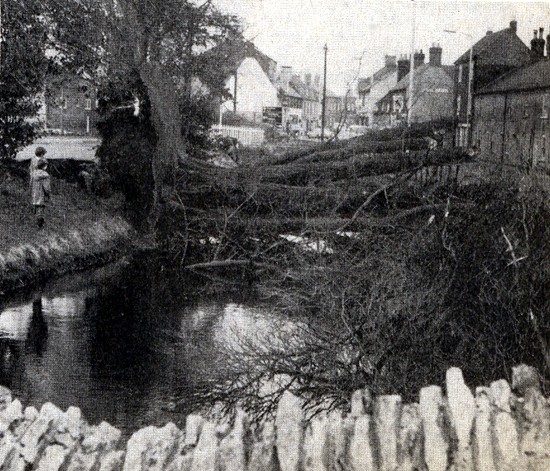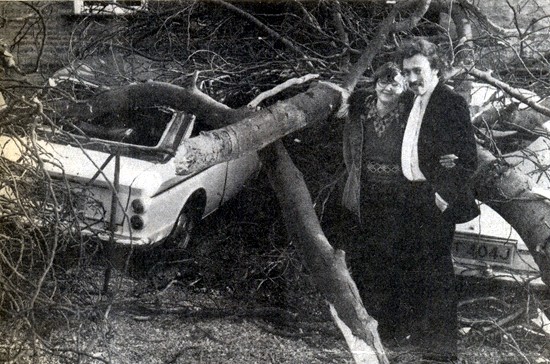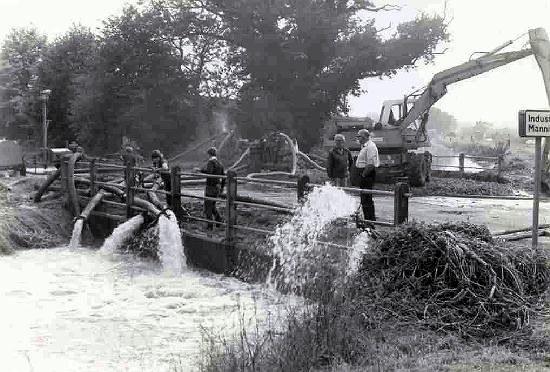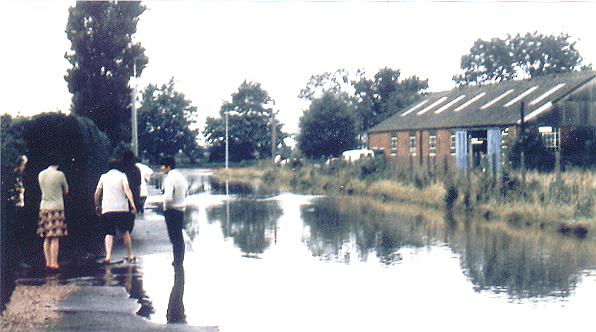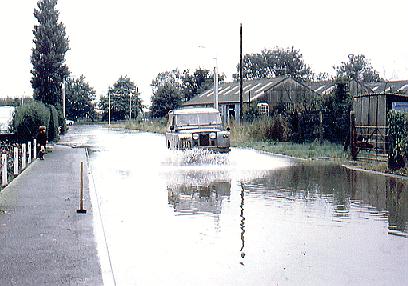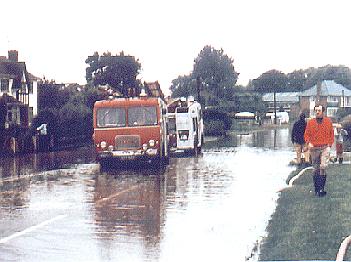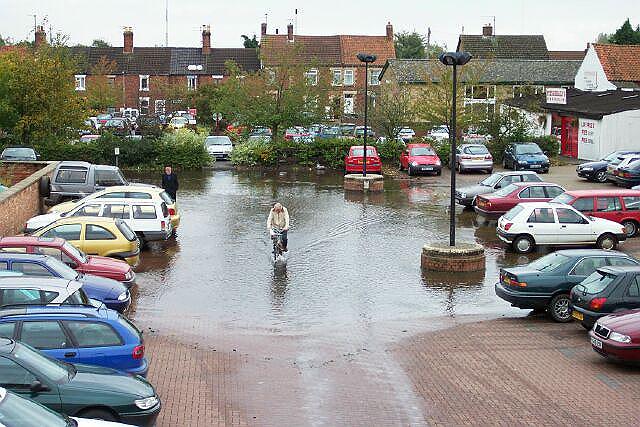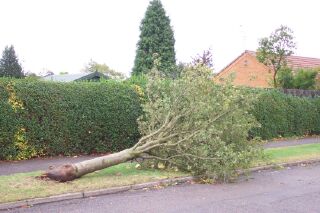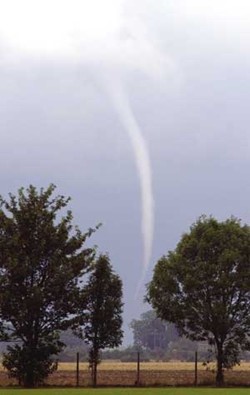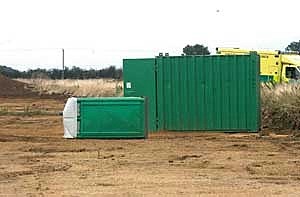|
Wind, fire and flood Bourne has had its share of
disasters that have brought their toll of loss and suffering to the town, the most far reaching being two fires that caused widespread damage during the early 17th century. A royal proclamation made soon after the fire stated that
Accordingly, by letters patent, the inhabitants of Bourne were authorised to receive the proceeds of collections which could be made for their assistance in numerous counties of England. Unfortunately, there is no record of the amount that was
raised. Signs of the great fire of 1605 were uncovered during excavations for the building of the present Woolworths store in North Street in January 1967. Layers of ash were discovered in the mediaeval strata dating back to the blaze and other subsequent fires that had broken out in the intervening years. There have been a number of big fires in recent years and in the winter of 1955, the records of 15,000 customers were destroyed when a blaze broke out in a wooden extension at the rear of the East Midlands Electricity Board offices in North Street, used as the accounts department where ten clerks usually worked and filled with equipment and filing cabinets. Flames thirty feet high were seen above the premises at the height of the outbreak and the contents were reduced to a mass of ash and twisted metal. The fire began in the early hours of Saturday 3rd December and was first spotted by Mr S Wood, manager of the Trustee Savings Bank, who lived in Burghley Street opposite. He woke to see the reflection of the flames on his bedroom wall and ran to the police station to raise the alarm. Police helped move inflammable packing cases and cable drums from the yard until the Bourne fire brigade arrived with two appliances and later the brigade from Spalding also turned up to give assistance and their action managed to prevent the flames from spreading to other premises in the vicinity. They were at the scene for four hours but were unable to save the board's records which affected electricity consumers from 350 square miles around the Stamford area while other parts of the premises including the offices and stores were also damaged. Mr Wood later gave an eye witness account of the fire. "At one time it was too hot to pass along the lane which ran beside the electricity board's yard even though it was enclosed by a high brick wall", he said. "Nearby was a fuel store but that was kept cool by the fire brigade who played water over it with a hose and a car and a van were also saved from a garage adjacent. It was fortunate that the wind was blowing from the south or considerable damage might have been done to the remainder of the board's offices and possibly other properties in North Street." The following year, fire destroyed a 60-foot long wooden classroom, also used as a dining room, at Bourne County Primary School in Abbey Road [now the Abbey Road Primary School] when the entire building was gutted within half an hour. The blaze broke out on Tuesday 7th February 1956 a few minutes before 100 children were due to assemble there for morning prayers. The outbreak was discovered by the school caretaker, Mr W Edwards, and was caused by a paraffin stove which had been lighted to warm the staff room becoming overheated and bursting into flames. He tried to put it out using three extinguishers but without success and so he raised to alarm but by the time the Bourne fire brigade arrived, the fire had taken hold and they were unable to save the building. Also lost were 20 new desks, canteen tables and forms, text and work books of 30 children who were normally taught there, puppetry work, instruments for the percussion band, new music stands, the school's collection of gramophone records, a piano and a quantity of personal possessions. The seven-year-old pupils who were normally taught there were dispersed throughout the school as a temporary measure while the 100 children who normally had their school dinners in the building ate their meals in a classroom and the headmaster, Mr G W Houghton, made arrangements for the meals to be supplied by the canteen at Bourne Secondary School in Queen's Road. "Education will carry on", said Mr Houghton bravely. "It is half term later this week but by next week we will have made some temporary arrangements for the accommodation of the entire class that has been displaced." In 1968, another big fire seriously damaged the premises of W A North and Sons Ltd., the forage and potato merchants, in West Street and in November 1979, the ambulance station in Queen's Road was destroyed by a tragic fire in which a young mechanic lost his life. One of the biggest countryside fires of
recent years occurred during a period of drought in the summer of 1976
when the grass and undergrowth became tinder dry because of weeks without
rain. The outbreak caused widespread damage to the farming area around
Cawthorpe, north of Bourne, and at one point endangered Bourne Wood but
teamwork by local firemen prevented the flames from spreading into the
trees and undergrowth. It began as a grass verge fire on the main A15 to
the north of the town in the late afternoon of Friday 23rd August but soon
spread into the fields, enveloping three miles of hedgerow, 300 acres of
stubble and many trees. Floods have been the worst of the natural disasters to affect Bourne, mainly because this has always been a farming community and in times of inundation, the land becomes unproductive and unworkable and so farm labourers were invariably sent home without wages until conditions improved. Flooding was a frequent occurrence before the fens were drained and the most serious recorded instance was in 1571. On November 5th that year, the entire county was struck by one of the worst storms in history. The roads into Bourne were turned into rushing torrents and the market place soon became a vast lake. The English chronicler Raphael Holinshed (flourished 1580) recorded that the flood water in Bourne rose "to midway of the height of the church walls" during a tempest which affected the whole district, particularly houses and other buildings on the eastern side of the town and thousands of sheep in nearby fields were drowned. The calamity was later described by the Lincolnshire poet Jean Ingelow (1820-97) in The High Tide on the Coast of Lincolnshire 1571: Then
bankes came down with ruin and rout, During the next century, in 1636, the parish registers record "a most fearful and terrible wind on the fourth of November in the nyght tyme" although the extent of the damage is not known. On 25th July 1760, a terrible storm of thunder, lightning and hail came in from the west, beating fruit from the trees and smashing windows. It lasted about fifteen minutes. In 1763, a harsh winter and cold spring were followed by widespread flooding in the fens around Bourne where a total of 22,000 acres were under water. An eye witness recorded that "no banks were able to oppose the amazing fury of the flood, the banks of Bourne and Baston being broke." Farm workers toiled day and night to fill the breaches using anything they could find, haystacks, wood and fencing. Eventually the north west wind that had been largely responsible for the disaster shifted although it was generally accepted that had it continued for even one hour more, the entire district would have been two feet under water. It was, said the eye witness, "the most general flood of the fens of Lincolnshire that was ever recorded or remembered by the oldest man living". Heavy snow caused problems in the winter of 1767. It started to fall on New Year's Day and continued without break for seven or eight days, accompanied by a severe freezing wind from the north east. There was a short break for some 24 hours but then it began to snow again and continued for a further six days "by which time", said an eye witness, "such a quantity had fallen as perhaps ever known in England and in several places in the neighbourhood it was thirteen feet deep and in other parts of Lincolnshire it was thirty feet deep. Several snow houses were built, wherein a number of people drank ale." Freak weather conditions and violent storms killed many people and livestock in Lincolnshire in the summer of 1783 although there are no records of the fatalities in the Bourne area. However, it was recorded that in June and July that year that "the sun (through a smoked glass) looked as red as blood at rising and in the evening till set, not the least beam from the body of it. Supposed to be caused by the nitrous particles and sulphurous matter in the atmosphere which was uncommonly hazy. The appearance was succeeded by the most tremendous thunder and lightning ever recorded in the history of England and I can safely affirm that scores of people were killed and a great number of cattle in various parts of the kingdom." At the beginning of the 19th century, more serious damage was caused when a ferocious thunderstorm accompanied by large hailstones hit the town on Sunday 4th May 1800 and raged for thirty minutes. It came from the south west, blowing down branches and trees and shattering windows. Several elms were torn up by the roots, birds killed in their nests and fields of corn destroyed. Some the the larger hailstones measured five inches in circumference and weighed upwards of three ounces. In the spring of 1862, hail and thunder storms swept through Bourne on two consecutive days with some ferocity. The first, at 4.30 p m on Tuesday 6th May, lasted for an hour and the rain was so heavy that the drains were unable to cope with the large body of flood water which soon covered the streets to a depth of several inches. An elm tree measuring 10-12 feet in circumference was blown down with terrific force at Bridge End, tearing up the earth for a considerable distance around while the hail stones were the largest ever witnessed. The next afternoon, Wednesday 7th May, there was more continual thunder accompanied by vivid flashes of lightning that killed several animals in the fields, including a horse near the toll bar in Mill Drove and two sheep at Rippingale. The Stamford Mercury reported the following Friday: The rain fell in torrents accompanied by hail varying in size from a bean to a pigeon's egg. Several hundred pieces of glass were broken in the Abbey garden hothouse and the conservatory and skylights in the Abbey were much damaged. It is feared the the hail has also done much damage to the fruit trees. South Street near the church was flooded from side to side. In the railway station yard, near the coal-drops, the water, from the inefficiency of the drains, was from three feet to six feet deep and the field next to the railway station was nearly covered with water to a considerable depth. The recent alterations to the drain under Coggles Causeway appears not to have had the desired effect. On Tuesday 30th May 1865, a gale of great severity swept through Bourne causing widespread damage. The force of the wind at its height may be judged by the fact that an old tree with a circumference of 15ft. in the paddock behind the North Street premises of Edward Wherry and Sons, grocers, hop and seed merchants, was snapped clean in two a few feet above the ground. Another violent storm passed over the Bourne area the following year with vivid flashes of lightning and loud peals of thunder. A large tree standing in the farm paddock owned by Mr G J Nicholls was struck, splitting it in two from top to bottom. But the severity of the storm was felt most at Billingborough, nine miles north of the town, and the drama was captured by the Stamford Mercury the following Friday 6th July 1866: On Saturday last, this place was visited by a most fearful thunderstorm. A slight shower of rain fell about one o'clock, attended with thunder and lightning, the latter of which was very vivid. The clouds then appeared to take a north easterly direction but at about 2.30, returned and there immediately followed frequent peals of thunder and flashes of lightning which appeared almost to rent the heavens and caused great alarm to all in the neighbourhood. The rain fell in torrents and quite deluged the streets and roads, the grates [drains] being incapable of receiving it. The oldest inhabitant cannot recollect such a violent storm. Great fears were entertained that much damage was done which was fully verified on inquiries being instituted. The electric fluid struck the roof of a cottage on the Folkingham road in the occupation of a labourer named Goodacre, but only caused slight damage. The following are the particulars of stock which were killed in this neighbourhood: Mr Thomas Sills of Billingborough, 4 sheep; Mr Tirrell of Horbling, one milch cow; Mr Albert Wadsley of Swaton, 2 pigs and 2 others seriously injured; Mr Quincey of Stow, 6 sheep; and Mrs Dean of Threekingham, 8 sheep. A great many trees were partly stripped of branches and one or two were split down the middle as though with an axe. At Scot Willoughby, the electric fluid killed an ewe and a lamb belonging to Mr Baker. The wool was severed from the lamb and forced a distance of thirty yards and the head was cut into small pieces. Four holes were made in the ground to the depth of several inches. Heavy rain fell in the Bourne area in the summer of 1875. The streets were so badly flooded on Tuesday 27th July that a boat was used to rescue marooned home owners in Star Lane [now Abbey Road] and it rained continually overnight, increasing fears that the Bourne Eau might burst its banks. An excursion train returning from Skegness was unable to travel further than Bourne because the floods had washed away the ballast from under the line between the town and Thurlby and consequently the rails had given way. Passengers on their way to Essendine and Stamford were given emergency overnight accommodation. The event was graphically described by the Grantham Journal on Saturday 24th July 1875: THE STORMS: On every day during the past week more or less rain fell, accompanied at all times with peals of thunder. On Monday evening, a very heavy shower fell, and the public drains being incompetent to carry away the water, the streets were flooded in several places; but the heaviest storm known here for several years was on Tuesday evening. Rain had fallen the greater part of the day, and at six it poured in torrents. Several shops and private houses in North Street were quickly flooded, a drain near the terrace being too small to carry away the water coming down from the woods. A large number of navvies were sent to watch the Bourne Eau bank, the water being very high and threatening to force away the banks in places. We are happy however to say nothing serious happened in that respect and thanks are due to Messrs Bettinson, Phillips, Shotbolt and other farmers, who laboured assiduously all night to prevent the dreaded catastrophe. Nearly all night, labourers were busy removing stock from flooded pastures, but in several instances their efforts were too late. A valuable cart horse belonging to R Mawby Esq. was drowned in the fen, and several small pigs in the town were also drowned in their sties. On the return of the excursionists from Skegness on Tuesday evening, it was found unsafe for the train to proceed further than Bourne, the floods having washed away the ballast from under the line between Bourne and Thurlby, and consequently the rails had given way. The Bourne and Essendine trains were also delayed on Wednesday morning. Some neighbouring places are in a precarious position. The main street in Deeping Saint James was impassable for horses and the lower rooms of many of the houses were deserted for a time. Many corn and hay fields are flooded in the villages around and pedestrian travelling impossible in many places. Some of the worst weather of the 19th
century occurred in 1880 when both town and country were badly affected.
The first severe storm broke out on Saturday 17th July when torrential
rain fell for two hours. "The rain came down so fast", reported the
Grantham Journal, "that it caused a flood as the water descending from
the fields near Bourne Wood congregated together in North Street opposite
the terrace and at one time was upwards of six feet deep in places. Every
house in the terrace was flooded and the occupants had to remove the
furniture on the ground floor to the upper rooms. This was done in every
case with the exception of Mr Brown's who was unable to move his furniture
on account of old age. The neighbours burst open the front door and found
the water in every room downstairs and the furniture floating about.
Several other portions of the town were flooded but not to any serious
extent." There was another violent thunderstorm on the evening of Tuesday 14th September accompanied by vivid flashes of lightning. "There was an incessant downpour of rain as the storm passed over the town", reported the Grantham Journal. "Several houses in the North Street narrowly escaped being flooded. No less than three fire balls were noticed to fall during the storm. No damage, however, has been reported. On Wednesday night and early on Thursday morning, immense quantities of rain fell, the water in the North Street opposite the terrace being three feet deep. Several houses in Albion Terrace were completely drowned out. The water rushed down Church Street like a torrent. The water in the Bourne Eau was at the top of the banks and in many places threatened to overflow. A great deal of corn is still in the fields." Further flooding occurred on Tuesday 5th October when heavy rain fell for 24 hours, again flooding the houses in the North Street terrace to a depth of several inches while in South Street, a wall leading to the station was breached by the weight of water from an adjoining field and flooded several houses in the vicinity. The Bourne Eau overflowed its banks in Eastgate and flooded houses around the Queen's Bridge and a man driving a horse and cart on the main Bourne to Stamford road at Toft was washed away by the flood and drowned. At Folkingham, continuous rain for a similar period raised water levels along the beck, flooding a larger area of surrounding countryside than had ever been known before. The rectory grounds were under water together with the kitchen garden which was badly damaged by the force of the current. The water rose almost two feet in the lower rooms of a house on the east side of the village and the occupants escaped through the upstairs windows. One of them, a lady of 80 years old who was trapped in a downstairs room, took refuge on a table and remained there until rescued two hours later. There was further serious flooding early in 1897 when streets and homes in the town were flooded and farmland in the Bourne area was badly affected. The Stamford Mercury reported the situation on Friday February 19th and questioned the efficiency of the flood defences: Beyond the muddy residuum upon the floors and carpets of the dwelling houses, nothing remained in the town to attest the almost unprecedented overflow of waters in our streets. Housewives had indeed a tough battle to wage against the unsavoury invader of the domestic peace. But in the fen, it was far different. The damage suffered there is unfortunately not of a temporary description and the disastrous effects will be long felt. For instance, Mr Charles Andrews has over 200 acres of land under water. Mr Thomas Brothwell has 150 acres submerged. These cases are typical. Devastation has been wrought, sudden and ruinous, and hundreds of acres of valuable land have been, at a critical point, submerged. The questions of practical consideration are: could this devastation have been averted? Were the precautions against the sudden oncoming of the flood effective and in readiness? Is it in any measure to be attributed to any degree of negligence or unpreparedness? There were two bad storms over Bourne in 1891. On Monday 10th August, the rain fell in torrents without a break from noon until 3 pm causing widespread damage to farm crops. The following month, a storm of unprecedented severity broke out at 1 pm on Monday 14th September. "Within a few minutes, the streets and the Market Place presented the appearance of canals, the drains being inadequate to convey the immense amount of water that fell", reported the Stamford Mercury. "The rain appeared to descend in one continuous sheet without intermission for fully half an hour. The phenomenon is said to bear a striking resemblance to a water spout breaking from the east. Within the immediate neighbourhood of Bourne, the storm necessitated the suspension of harvest operations although at Tongue End, about four miles distant, work was not hindered for more than 20 minutes to half an hour." GALE LEAVES TRAIL OF DAMAGE A terrific south westerly gale swept through the Bourne area on Thursday 12th January 1899 which, according to the Stamford Mercury, "left traces of its devastating force". The report continued: Several orchards suffered severely. In Mr Berry's orchard in Star Lane, a fine pear tree was uprooted. A splendid chestnut tree near Mr Seward's residence in Dyke was blown down and a fine tree in Park Field near the station was snapped. The advertisement hoardings in Mr Dallywater's near the station, were hurled into the road. In the farm yards, many stacks were scattered. Tiles were also blown from the houses and, in two or three instances in Eastgate, the places were partially disroofed. The tall chimney of the National School was broken by the force of the wind and fell crashing on the roof. This happened about half-past seven in the evening. The crash alarmed Mrs Hallam, the school cleaner, who was in the building at the time. The debris of the storm was strewn about the streets and lanes. On Friday, builders were busy everywhere repairing damage. The gale sprang up soon after noon, following a heavy and sudden shower. It increased in violence until eight when its maximum intensity was attained. It continued to rage until after midnight. By seven on Friday morning, it was calm as a day in spring. HOUSES STRUCK BY LIGHTNING There has been heavy rain and flooding in Bourne during more recent times. One of the worst thunderstorms occurred in the early hours of Tuesday 31st May 1904 when there was heavy rain and hailstones "of an unusual size", damaging crops in the fields, particularly potatoes and in many instances, the tops were cut off at ground level. The Stamford Mercury reported: "Whilst the storm was at its height, Mr J W Lunn's house in Eastgate was struck by lightning. Two courses of brickwork were hurled from the chimney and the tiles were broken with the falling debris. The current penetrated the brickwork in two places; in one instance, it went through the wall and into a cupboard, shifting most of the things in it. The occupants were at the other end of the house and did not suffer any injury. The storm was followed by almost continual rain during the day, especially in the afternoon." There were several violent thunder and hail storms in the town in 1910, particularly over the weekend of 19th-20th February when gales wrecked trees and property including a stable roof in North Road that was completely blown away. There was more extreme weather on July 3rd when the chimney of a house in Abbey Road was struck by lightning, stripping the tiles off the roof and hurling fragments across the road. The flash continued into the Abbey Lawn where it scorched the leaves off a tree and stripped another of its bark. A Miss Flatters was struck as she was walking down the road and according to one newspaper report, "was overcome by the electric fluid and had to sit down on the grass until a policeman arrived to render assistance". The chimney of a house in Woodview was also hit by lightning, damaging tiles and guttering, and two poplars on the Spalding Road were splintered. The village of Rippingale, five miles north of Bourne, caught the full force of a violent storm that swept through South Lincolnshire on 28th and 29th April 1913. The Stamford Mercury reported: Shortly before 6 o'clock on Monday evening, a tremendous rainstorm burst over the village and during its progress the wind blew with hurricane force, indeed, for a width of about 50 yards, something in the nature of a tornado swept across the district. Trees were uprooted in several places and one which fell, all but dismantled a house. Roofs of farm buildings in the occupation of Mr Richard Miller and Mr Worsdale were considerably damaged - portions being completely stripped - and two haystacks belonging to Mr George Jessop were blown over. This was followed on Tuesday night by a thunderstorm of remarkable violence. Heavy rain and hail fell during the progress of the storm and just over half-an-inch of rain was registered.
More heavy rainfall occurred during the summer of 1915. A violent thunderstorm broke out on Tuesday 29th June accompanied by torrential rain that continued for two days, flooding the streets that soon became impassable. The situation worsened as the bad weather continued throughout Wednesday when there was another heavy storm soon after 1 p m accompanied by vivid flashes of lightning and loud thunder claps. North Street was particularly badly hit because the drains were unable to cope with the excess water that ran into shops and flooded them to a depth of several inches. Girls who were attending the council school were evacuated in vehicles because of the deep floodwater outside in the street and by evening there were no signs of the downpour abating. The rain continued intermittently for another ten days, flooding hundreds of acres of farmland in the area, disrupting agricultural operations and ruining the hay harvest. The following year, a whirlwind hit Bourne causing widespread damage to several properties. It occurred on Wednesday 5th July 1916 when part of the roof on the Corn Exchange was lifted off into the street below and the slates were ripped off the roof of Mr William Pearce's shop premises in North Street. Dozens of windows in private homes were shattered and in many cases, the fire in the grate was blown away. There was also considerable damage to the newly completed Isolation Hospital in South Road and the Stamford Mercury reported that "in some yards around the town, water tubs were blown around like feathers". A THUNDERBOLT DOWN THE CHIMNEY Violent storms in the autumn of 1926 left two families homeless at Market Deeping. They broke out soon after 2.30 pm on Friday 24th September and half an hour later, lightning struck a pair of thatched cottages in Towngate, leaving only the charred walls standing amid a pile of smouldering debris. Two families were left homeless, Mr and Mrs Exton and their eight children and Mr and Mrs Watson who lived next door. Mrs Exton, who was in the cottage and was lucky to escape alive, described the incident afterwards with the help of a local newspaper reporter: "A thunderbolt, like several balls of fire, came down the wide, old-fashioned chimney and dropped on to the mat. It came which such tremendous force that it knocked over our grandfather clock, blew in the window and made the ceiling collapse. I was knocked over by the clock and pinned to the ground, partially stunned. The rug caught fire and within minutes, the stairs and thatched roof were blazing furiously. My husband was in the yard and came back into the cottage and rescued me from my perilous plight but he was lucky to reach me because the other rooms had been cut off by the flames which spread with alarming rapidity and burned with great fierceness. Fortunately, our twins were outside in the yard when this happened and the other children were at school. I have never seen anything like this before and I never want to again. We have only been able to save a few things but happily all of the damage we have suffered is covered by insurance." The Watsons next door were more fortunate and removed all of their furniture and belongings before the blazing thatched room of the cottages collapsed. Horses and other animals in a stable at the rear of the premises were turned out into a nearby orchard and the Market Deeping fire brigade managed to prevent the flames from spreading to other homes nearby although they were unable to save a hay stack in the vicinity. Both families were found alternative accommodation before nightfall. During the storm, Mr Broughton, a baker from Langtoft, was driving his pony and cart through Market Deeping when lightning shattered the harness on the pony's back but Mr Broughton, his son, and the pony miraculously escaped unhurt.
A violent thunderstorm accompanied by thunderbolts and half an hour of torrential rain within half an hour also brought serious flooding to many streets in the town on the evening of Monday 4th July 1932. Tradesmen had difficulty is preventing water from gushing into their premises and houses in Willoughby Road and Hereward Street were also affected while the road near the Butterfield Hospital was under a foot of water. Sewers were unable to cope with the increased flow and as raw sewage floated into the streets there were fears of a health hazard with the result that Bourne Urban District Council sent out workmen to spray disinfectant over the affected areas. In more recent times, the worst weather to hit Bourne occurred on Saturday 7th March 1959 when the recently installed sewers in North Street were tested to the limit by a severe thunderstorm and a prolonged downpour. Householders in Woodview spent an anxious six hours as water levels in the streets outside rose, aggravated by the flow from higher ground around Bourne Wood where the culverts were unable to cope. Pantries, sculleries and gardens were flooded and at one time there was flooding two feet deep across North Road opposite the Butterfield Hospital where the rising water poured across the pavements and into the grounds. The stream behind Harrington Street was unable to cope, overflowing into nearby houses and covering the road and pavement to a depth of several feet. Bourne fire brigade were working flat out trying to contain the flooding and they were joined by detachments from Corby Glen and Sleaford. The firemen were eventually pumping for a total of eight hours moving an estimated 250,000 gallons of water but by Sunday morning the worst was over. The flood water has started to subside and the main casualty had been the Lincolnshire Senior Cup football semi-final between Bourne Town and Louth United at the Abbey Lawn which was abandoned after 15 minutes of play because the water was ankle deep on the pitch. Groundsman Bert Allett said afterwards that he had never seen such awful ground conditions in 50 years. In 1960 there was a heavy mid-week downpour when three inches
of rain fell in ninety minutes. The violent thunderstorm occurred on Wednesday 5th October and although it was early closing day, shopkeepers had to return to their premises to mop up. Traffic was brought to a standstill as roads quickly turned into lakes, cars were stranded, shops and houses flooded and daily life totally disrupted by the downpour. The fire brigade worked non-stop in an attempt to keep the floodwater at bay but were powerless to stem the inundation.
A hurricane hit South Lincolnshire during Friday night 2nd January 1976 leaving a trail of damage in which two people were killed and although Bourne was on the very edge of the disaster area there were many major incidents. The meteorological office at RAF Wittering reported gusts of up to 105 mph and several properties were badly affected, trees and television aerials toppled and telephone wires and power cables brought down and although no one was hurt several escaped serious injury. Mrs Ethel Dove, an elderly resident of 26 Victoria Place, was fortunately away visiting relatives when the roof of her house caved in but the police broke in fearing that she may have been trapped inside and found the bedroom covered in rubble. The gable end of a house at 59 Spalding Road was also blown away but fortunately the family that lived there was out.
Trees were toppled in the Memorial Gardens, in Charles Close where a parked car was damaged and two more which were felled in Church Walk prevented owners from reaching their vehicles. Fallen trees blocked the A15 road at the north and south entrances to Bourne and the main road to Stamford was blocked at the Witham-on-the-Hill crossroads. There were similar obstructions at Pointon and Dunsby while a couple were trapped in their car for twenty minutes when a tree collapsed on it as they were leaving the Black Horse at Grimsthorpe, also damaging the car of another couple who were spending their honeymoon night at the inn. Sixty yards of wall were also blown down alongside the A151 at Grimsthorpe while five of the pinnacles on St Andrew's Church at Sempringham were blown away together with the weathercock on the steeple of the village church at Castle Bytham.
After a month long dry spell, rain came to Bourne on Tuesday 15th October 2002 with a vengeance with a downpour that lasted for more than 18 hours and was accompanied by high winds. There were few householders that were not affected in some way, with gardens littered with debris, flower tubs and bird tables blown over, patios and driveways flooded and trees that had lost their branches or had even been toppled. The paved area behind the Town Hall where the weekly markets are held was flooded to a depth of several inches which is surprising because it was built as recently as 1990. Fortunately, the floodwater had subsided by the time the Thursday stallholders had arrived.
There were further storms over the weekend of Saturday and Sunday 26th/27th October 2002 when wind forces reached 90 mph. Most of Bourne lost its electricity for much of the day and the gales toppled several trees in the area, including a large fir in the grounds of the outdoor swimming pool, and tore the roof off Bourne Town Football Club's stadium at the Abbey Lawn, depositing 20 sections of corrugated zinc in two nearby gardens and causing £3,000 worth of damage. A large branch was also ripped off the historic oak tree at Bowthorpe Park farm near Manthorpe. In 2004, torrential rain caused widespread flooding and other damage in Bourne, closing shops and streets which were several inches under water within an hour. The storm broke soon after 6 pm on Thursday 22nd July with violent thunder and lightning and lasted for two and a half hours. Roads were soon underwater as drains overflowed. The town centre at Bourne was badly affected and firemen were called out to pump water from several shops in North Street and West Street where many lost stock as a result. Sainsbury's store in Exeter Street was also damaged after the roof collapsed and was forced to close early while a car auction salesroom in Cherryholt Road was so badly flooded that customers attending a sale clambered into the cars for safety until the water had subsided. The Leisure Centre in Queen's Road suffered structural damage after the gym was flooded and the roof of the cafe collapsed and was forced to close. A spokesman at the Meteorological Office suggested that the town had been hit by a tornado while Lincolnshire fire brigade reported 200 calls connected with storm damage. On Thursday 17th August 2006, a tornado swept through Baston, near Bourne, leaving a trail of damage and several people injured. The tornado struck at 2.30 pm after a violent thunderstorm and a portable canteen being used by a five-member archaeology team carrying out soil tests in a nearby gravel pit was overturned, four of the occupants being hurt. The project supervisor, Ailsa Westgarth, said afterwards: "We were dragged 70 feet and the cabin rolled over half a dozen times in the process." Trees were also brought down, damaging five parked cars. Denham Hughes, aged 39, who was working outside near his home in Deer Park Road, Baston, saw the wind spout sweeping in from over the fen. "The clouds appeared to be behaving rather oddly and then turned very, very black and suddenly a funnel appeared at the base", he said. "It was long and slender and must have been about 1,000 feet high. I tried to follow it in my car and saw the damage that it left behind with wood and metal sheets all over the place but it headed back out into the fen where the top half disappeared and then re-formed before dissipating completely." Meteorological experts at the nearby Royal Air Force base at Wittering estimated wind speeds surrounding the tornado at between 60 and 90 mph. There was further flooding in 2016 when the country was experiencing one of the wettest months of June on record with rain most days, often prolonged and accompanied by thunder and lightning. During a series of particularly heavy downpours on Wednesday 15th June when firemen attended 21 calls around the town to pump out flood water. There was serious flooding in Beech Avenue, Harrington Street, North Road and Eastgate while roads were also underwater at Toft, Haconby, Morton and Thurlby. Walkers also reported that several of the main paths through Bourne Wood were under water.
REVISED JUNE 2016 See also The Great Fire of 1605 The storm of 1800 The Cliffe shop fire of 1898 The Meadowgate fire of 1922 The Baptist Chapel fire of 1897 The Branston shop fire in Eastgate North's of Bourne Earthquakes Lightning Disastrous fen floods of past times
Go to: Main Index Villages Index |
|||||||||||||||||||||||||||||||||||
